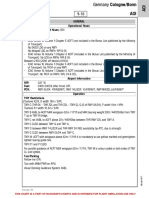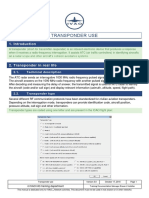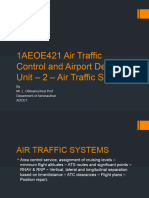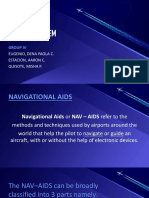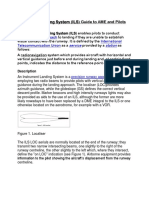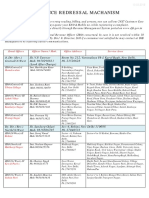Marker Becans Theory
Marker Becans Theory
Uploaded by
Ajay ShokeenCopyright:
Available Formats
Marker Becans Theory
Marker Becans Theory
Uploaded by
Ajay ShokeenOriginal Description:
Copyright
Available Formats
Share this document
Did you find this document useful?
Is this content inappropriate?
Copyright:
Available Formats
Marker Becans Theory
Marker Becans Theory
Uploaded by
Ajay ShokeenCopyright:
Available Formats
Page |1
Marker Beacons
The ILS marker beacon subsystems give pilots location references. Consisting of an outer marker, a middle marker and, in some cases, an optional inner marker. These beacons provide a pilot on final approach a series of visual and audio indications of precise position reference points. The Marker Beacon components of the ILS operate on 75 MHz and are identified by Outer, Middle, and Inner along the final approach course. These marker beacons indicate when to execute the procedure turn, when the pilot has reached the decision height, and when the runway threshold is imminent. Electrical/Hardware Details
By : Ajay Shokeen, Air India Limited,NR
Page |2
Outer Marker: The Outer Marker uses the dual V-Yagi antenna which gives greater range to cover signal requirements for aircraft intercept at the higher altitudes.
This component may also be used as an airway marker and as a fan marker for non-precision approach aids such as a TVOR. The Outer Marker is located 4 to 7 NM from the runway threshold, and marks the procedure turn (or minimum holding altitude) for the pilot. Upon intersecting the outer marker, the pilot may start descent on the glideslope to the runway. The indication inside of the cockpit is a continuous series of 400 Hz audio "dashes" and a flashing blue "marker" light until past the station.
By : Ajay Shokeen, Air India Limited,NR
Page |3
Middle Marker : The Middle Marker is located approximately 1070 meters (3500 ft.) from threshold and establishes the decision height (missed approach point) for Category I operation. For Category II and III, the pilot may descend beyond this point. The Middle Marker is modulated at 1300 Hz. The pilot is notified when crossing the Middle Marker by a flashing amber light and a series of alternate "dots" and "dashes" in the aircraft audio system.
By : Ajay Shokeen, Air India Limited,NR
Page |4
Inner Marker: The Inner Marker is located approximately 92 to 610 meters 330 to (2000 ft.) from threshold and establishes the decision height (missed approach point) for Category II and III operation. The Inner Marker is modulated at 3000 Hz. The pilot is notified when crossing the Inner Marker by a flashing white light and a series of "dots" in the aircraft audio system.
The Middle and Inner Markers use the single Yagi in lieu of the dual V-Yagi used at the outer marker. The single Yagi is fully adequate to meet signal requirements at these points, and cost savings are realized over the dual V-Yagi system.
By : Ajay Shokeen, Air India Limited,NR
You might also like
- 737 Performance Reference Handbook - EASA EditionFrom Everand737 Performance Reference Handbook - EASA EditionRating: 4.5 out of 5 stars4.5/5 (3)
- Changes: Nil: This Chart Is A Part of Navigraph Charts and Is Intended For Flight Simulation Use OnlyDocument46 pagesChanges: Nil: This Chart Is A Part of Navigraph Charts and Is Intended For Flight Simulation Use OnlytomrachNo ratings yet
- Airport Signs and MarkingsDocument47 pagesAirport Signs and MarkingsAvilea Renata100% (3)
- Instrumentation Landing SystemDocument4 pagesInstrumentation Landing SystemPrabuddha ChakrabortyNo ratings yet
- C5 Galaxy Pilot GuideDocument18 pagesC5 Galaxy Pilot Guidebbarry138No ratings yet
- Instrument Landing SystemDocument16 pagesInstrument Landing SystemRana AsimNo ratings yet
- Prepared By: Harjeet Singh Ishita Rana Iqra HussainDocument18 pagesPrepared By: Harjeet Singh Ishita Rana Iqra HussainHarjeet SinghNo ratings yet
- Instrument Landing System (ILS) How It WorksDocument44 pagesInstrument Landing System (ILS) How It WorksMark Santiago AlbusNo ratings yet
- Instrument Landing System Documantation1Document15 pagesInstrument Landing System Documantation1Chara GalaNo ratings yet
- ILSDocument39 pagesILSRezie Dampog Dellava100% (3)
- Airport DesignDocument30 pagesAirport DesigndhavamanidossNo ratings yet
- Instrument Landing SystemDocument14 pagesInstrument Landing SystemRAMUNo ratings yet
- Radio Navigation Aids in BriefDocument8 pagesRadio Navigation Aids in BriefZulfiqar MiraniNo ratings yet
- ILS Instrument Landing System Report GerwinDocument26 pagesILS Instrument Landing System Report GerwinDaryl LopezNo ratings yet
- General Info about nav equipmentDocument7 pagesGeneral Info about nav equipmentAhmed bohyNo ratings yet
- Ils GSDocument9 pagesIls GSajrio1785No ratings yet
- Ils 151109090751 Lva1 App6892 PDFDocument31 pagesIls 151109090751 Lva1 App6892 PDFĐào Nguyên TuếNo ratings yet
- Instrument Landing System (Ils)Document26 pagesInstrument Landing System (Ils)Cyrus Stephen BanoNo ratings yet
- Instrument Landing System - Wikipedia, The Free EncyclopediaDocument10 pagesInstrument Landing System - Wikipedia, The Free EncyclopediaGavin DunnettNo ratings yet
- Instrument Landing System1Document52 pagesInstrument Landing System1om98474831879339No ratings yet
- ILS and MLS REPORTDocument37 pagesILS and MLS REPORTCindy AyenNo ratings yet
- Rad 7Document28 pagesRad 7Anonymous 32VX8LNo ratings yet
- VDGS PPT 1Document70 pagesVDGS PPT 1ramakrishnaNo ratings yet
- Airport Design 3Document15 pagesAirport Design 3aronjohncunanan28No ratings yet
- Microwave Landing System: Name: Nakkanaboina Subhash ROLLNO: 18BB1M1109 Branch: AvionicsDocument45 pagesMicrowave Landing System: Name: Nakkanaboina Subhash ROLLNO: 18BB1M1109 Branch: AvionicsSubhash Nakkanaboina100% (1)
- The Instrument Landing SystemDocument12 pagesThe Instrument Landing Systemorcman77No ratings yet
- Instrument Landing SystemDocument18 pagesInstrument Landing SystemElcar Tíquico100% (1)
- Aerenmgt PPT 6 (Aerodrome Facilities Part 2)Document57 pagesAerenmgt PPT 6 (Aerodrome Facilities Part 2)큐피드 CUPIDNo ratings yet
- ILS SeminarDocument17 pagesILS SeminarSiddharth SoniNo ratings yet
- SPP ADC Instrument Flight RulesDocument3 pagesSPP ADC Instrument Flight RulesMatias Javier AlvarezNo ratings yet
- Instrument Landing SystemDocument41 pagesInstrument Landing SystemShahid SohailNo ratings yet
- Chapt - 08 Airport Navigational Aids PDFDocument11 pagesChapt - 08 Airport Navigational Aids PDFPearl BeatriceNo ratings yet
- PP ADC TransponderDocument12 pagesPP ADC TransponderEduardo Almeida SilvaNo ratings yet
- Navigatinal AidDocument29 pagesNavigatinal AidM.Tanseer Sibtain razaNo ratings yet
- SmgcsDocument2 pagesSmgcsJulian Marin SinisterraNo ratings yet
- 09 Instrument Landing SystemDocument15 pages09 Instrument Landing Systemshyamsankar11100% (1)
- IlsDocument18 pagesIlsFawad Afzal100% (1)
- UntitledDocument2 pagesUntitledSuleyman GafarovNo ratings yet
- XASE18-Navigation SystemDocument105 pagesXASE18-Navigation SystemVigha Omnica Iyer100% (2)
- AirtrafficcontrolDocument17 pagesAirtrafficcontrol198W1A0125Sec-A MADIPALLI KRANTHI BHUSHANNo ratings yet
- UntitledDocument2 pagesUntitledSuleyman GafarovNo ratings yet
- Air Traffic Control and Airport Design Unit 2Document60 pagesAir Traffic Control and Airport Design Unit 2Prof L. OblisamyNo ratings yet
- Amte 229 IlsDocument48 pagesAmte 229 IlsPamela Bianca PalatinoNo ratings yet
- ILS Instrument Landing System: Nithiyanantham K KDocument40 pagesILS Instrument Landing System: Nithiyanantham K KThejeshwarrNo ratings yet
- Instrument Landing SystemDocument35 pagesInstrument Landing SystemDena EugenioNo ratings yet
- Departure Procedures and ChartsDocument8 pagesDeparture Procedures and ChartsLemi Chala BeyeneNo ratings yet
- Instrument Landing SystemDocument62 pagesInstrument Landing Systemzeeshan_946461113100% (1)
- Basic Avionics PresentationDocument148 pagesBasic Avionics PresentationCdr. Pearl100% (14)
- Instrument Landing System GuideDocument4 pagesInstrument Landing System GuidePrabuddha ChakrabortyNo ratings yet
- Internship at AAI BarodaDocument24 pagesInternship at AAI BarodaShubham Sehrawat100% (1)
- Radio Navigation Aids Presentation 2 Navaids RadarDocument54 pagesRadio Navigation Aids Presentation 2 Navaids RadarZulfiqar Mirani100% (2)
- AtcDocument48 pagesAtcfrancis GodoyNo ratings yet
- Localizer & Glide PathDocument3 pagesLocalizer & Glide PathMohit BoliwalNo ratings yet
- ADF (Automatic Direction Finder)Document6 pagesADF (Automatic Direction Finder)gregmNo ratings yet
- Runway LightingDocument4 pagesRunway LightingfacedoneNo ratings yet
- H1 - 1. Introduction ILS PDFDocument38 pagesH1 - 1. Introduction ILS PDFmuhammad farhanNo ratings yet
- Ils MSL Dme SystemDocument91 pagesIls MSL Dme SystemH R VALANo ratings yet
- SPP APC Minimum Flight Altitude PDFDocument8 pagesSPP APC Minimum Flight Altitude PDFMohammed Alsbeay0% (1)
- Instrument Approach: ILS MLS PAR Military GPS Waas Egnos Laas Jpals GCADocument8 pagesInstrument Approach: ILS MLS PAR Military GPS Waas Egnos Laas Jpals GCASheikh Mahmud HabibNo ratings yet
- A330 Normal Law: Putting Fly-by-Wire Into PerspectiveFrom EverandA330 Normal Law: Putting Fly-by-Wire Into PerspectiveRating: 5 out of 5 stars5/5 (2)
- First Floor Working-1Document1 pageFirst Floor Working-1Ajay ShokeenNo ratings yet
- Ground Floor D&WDocument1 pageGround Floor D&WAjay ShokeenNo ratings yet
- Tipitaka: Suttasaar: Vol. 1 Digha Nikaya & Majjhima Nikaya (Hindi)Document230 pagesTipitaka: Suttasaar: Vol. 1 Digha Nikaya & Majjhima Nikaya (Hindi)Singh1430100% (2)
- ZRO+Telephone+list+ver+3 11Document4 pagesZRO+Telephone+list+ver+3 11Ajay ShokeenNo ratings yet
- Nangloi-Zone DJB PDFDocument2 pagesNangloi-Zone DJB PDFAjay ShokeenNo ratings yet
- ZRO+Telephone+list+ver+3 11Document4 pagesZRO+Telephone+list+ver+3 11Ajay ShokeenNo ratings yet
- NAAC Final GargiDocument53 pagesNAAC Final GargiAjay ShokeenNo ratings yet
- Copy of Sindhi and Muhajir Conflict in Pakistan by Angel Colon On PreziDocument3 pagesCopy of Sindhi and Muhajir Conflict in Pakistan by Angel Colon On PreziAjay ShokeenNo ratings yet
- MQM Manifesto 2013 EngDocument34 pagesMQM Manifesto 2013 EngAjay ShokeenNo ratings yet
- History of Department of Political Science Zakir Husain Delhi Coolege University of DelhiDocument1 pageHistory of Department of Political Science Zakir Husain Delhi Coolege University of DelhiAjay ShokeenNo ratings yet
- Aircraft Radio SystemsDocument259 pagesAircraft Radio SystemsManali VartakNo ratings yet
- Mechanical Engineering Series: SpringerDocument15 pagesMechanical Engineering Series: SpringerAjay ShokeenNo ratings yet
- Aircraft Attitude IndicatorDocument3 pagesAircraft Attitude IndicatorAjay ShokeenNo ratings yet
- Riotograph Ofthe CandidateDocument2 pagesRiotograph Ofthe CandidateAjay ShokeenNo ratings yet
- The Hidden Hazards of Microwave CookingDocument13 pagesThe Hidden Hazards of Microwave Cookingrajronson6938No ratings yet
- Ame Ref-Books PDFDocument4 pagesAme Ref-Books PDFAjay Shokeen100% (1)
- ICAO Annex 14 Volume 1 CH10Document6 pagesICAO Annex 14 Volume 1 CH10Zero RequiemNo ratings yet
- BAA FCTM Rev 1 PDFDocument201 pagesBAA FCTM Rev 1 PDFChris ChungNo ratings yet
- E5AE - Entities and Attributes v4.1.0.3Document109 pagesE5AE - Entities and Attributes v4.1.0.3SOLTANI MehdiNo ratings yet
- Aips 2020 29Document2 pagesAips 2020 29Piyush MankaniNo ratings yet
- Kiadeham PDF 1694091427Document101 pagesKiadeham PDF 1694091427Sao Kit PangNo ratings yet
- Air Regs HandbookDocument90 pagesAir Regs Handbookjitansh singhNo ratings yet
- Jeppesen Instrument/Commercial Manual - "Approach Charts" Chapter 7, Section A Instrument Flying Handbook 8-13 To 8-32Document4 pagesJeppesen Instrument/Commercial Manual - "Approach Charts" Chapter 7, Section A Instrument Flying Handbook 8-13 To 8-32intern_mikeNo ratings yet
- Manual de PFD FMA Airbus A320httpsyoutu - beub36ffWAqgQ 2Document51 pagesManual de PFD FMA Airbus A320httpsyoutu - beub36ffWAqgQ 2Leonardo Serrano100% (2)
- Advisory Circular NCAA-AC-PEL 025Document25 pagesAdvisory Circular NCAA-AC-PEL 025IdrisNo ratings yet
- I.F Test QuestionsDocument1 pageI.F Test QuestionsJake CoetzeeNo ratings yet
- Notam AbbreviationDocument39 pagesNotam Abbreviationthebigkahuna81No ratings yet
- Instrument RatingDocument110 pagesInstrument RatingAndy Pats100% (1)
- Vyyy Hguvordme21 Airac 2018 03Document1 pageVyyy Hguvordme21 Airac 2018 03shan ma layNo ratings yet
- FF Plate BinderDocument15 pagesFF Plate BindermickalvarezrNo ratings yet
- 8260 19DDocument303 pages8260 19DSry SantosNo ratings yet
- Civil Aviation Requirements Section 8 - Aircraft Operation Series B Part I Dated 30 MARCH, 2001Document16 pagesCivil Aviation Requirements Section 8 - Aircraft Operation Series B Part I Dated 30 MARCH, 2001Sawan KumarNo ratings yet
- BEING PREPARED For GO-AROUNDDocument7 pagesBEING PREPARED For GO-AROUNDNHAN TRINHNo ratings yet
- Radio AltimeterDocument4 pagesRadio Altimetermadhur chaurasia67% (3)
- Hard and Bounce PDFDocument10 pagesHard and Bounce PDFTun WaiNo ratings yet
- LSGGDocument56 pagesLSGGnpstx2nrg2No ratings yet
- LTFG/GZP Gazipasa, Turkey: Batnu 1C Elrop 1C Utuso 1CDocument10 pagesLTFG/GZP Gazipasa, Turkey: Batnu 1C Elrop 1C Utuso 1CTweed3ANo ratings yet
- Aviation InfrastructureDocument53 pagesAviation InfrastructureHitesh SunnyNo ratings yet
- SPP APC IFR PhraseologyDocument28 pagesSPP APC IFR PhraseologyAndreiNo ratings yet
- DGCA Operations Circular No 6 1999 Aerodrome MinimaDocument80 pagesDGCA Operations Circular No 6 1999 Aerodrome MinimaDevesh AgarwalNo ratings yet
- Abbreviations and Codes: Eighth Edition - 2010Document18 pagesAbbreviations and Codes: Eighth Edition - 2010Pierre BouvierNo ratings yet
- Nbaa Twincessnasp FlightopsmanualDocument20 pagesNbaa Twincessnasp Flightopsmanuala320No ratings yet
- Ground Handling ManualDocument312 pagesGround Handling ManualEgsiam SaotonglangNo ratings yet
- 070-Operational ProceduresDocument191 pages070-Operational ProceduresDaniel MkenyaNo ratings yet

